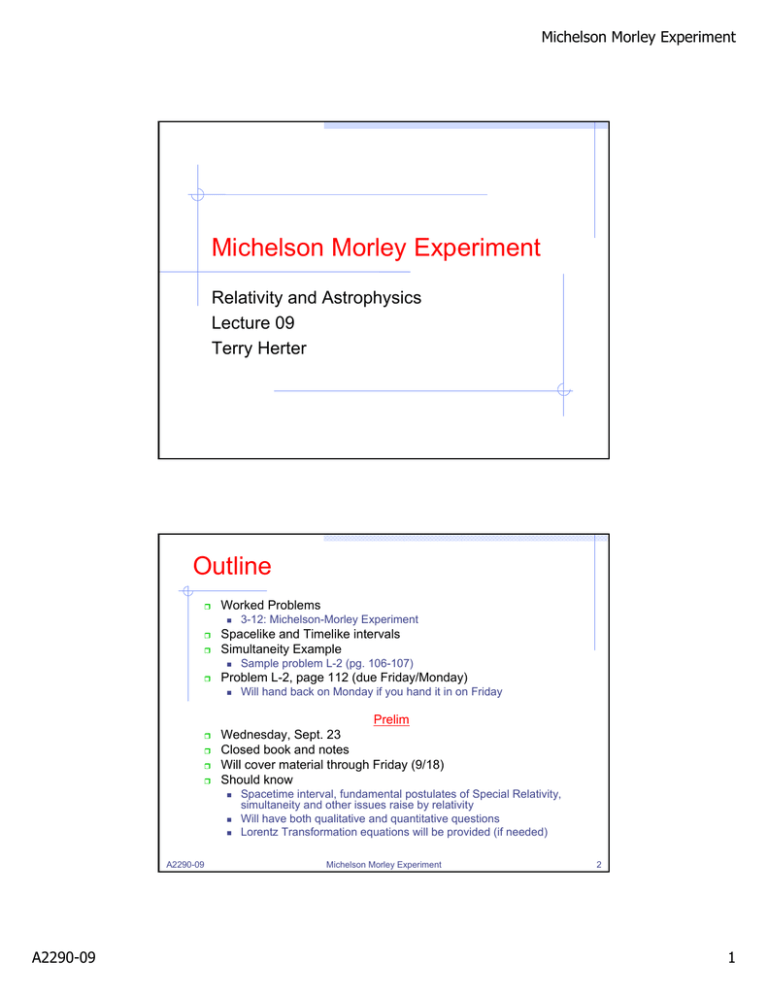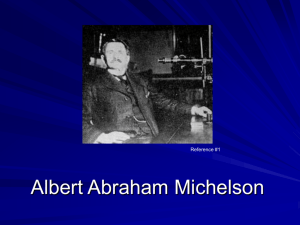Michelson Morley Experiment Outline
advertisement

Michelson Morley Experiment Michelson Morley Experiment Relativity and Astrophysics Lecture 09 Terry Herter Outline Worked Problems Spacelike and Timelike intervals Simultaneity Example Problem L-2, page 112 (due Friday/Monday) A2290-09 Sample problem L-2 (pg. 106-107) Will hand back on Monday if you hand it in on Friday Prelim Wednesday, Sept. 23 Closed book and notes Will cover material through Friday (9/18) Should know A2290-09 3-12: Michelson-Morley Experiment Spacetime interval, fundamental postulates of Special Relativity, simultaneity and other issues raise by relativity Will have both qualitative and quantitative questions Lorentz Transformation equations will be provided (if needed) Michelson Morley Experiment 2 1 Michelson Morley Experiment Michelson-Morley Exp. (Prob. 3-12) Suppose we have a plane flying from point A to point B with velocity c Let the distance from A to B be L, then the time to travel back and forth with no wind is Traveling along wind direction tn 2 L c For a wind blowing with velocity, v, blowing from A to B, the travel time from A to B (with the wind) is t AB L c v L A c c B v Flying back against the wind, the travel time is t BA L c v Summing gives the total time t ABA t AB t BA t ABA 2c L L L 2 2 c v cv cv 2L 1 c 1 v2 / c2 Note that this is highly non-linear, if v > c you can’t fly back from B to a! Relative to the no wind time, we have t ABA 2c c 1 L 2 2 tn c v 2L 1 v 2 c 2 A2290-09 Michelson Morley Experiment 3 Problem 3-12b Now suppose the plane flies from A to C with the wind perpendicular to the direction of motion. The air speed is still c Traveling to wind direction But the plane has to fly into the wind with a velocity component equal to v or it will go off track, that is, c v L y Let cx be the velocity component in the x direction (A-C direction), then A c 2 cx2 c y2 c x2 v 2 The travel time from A to C is t AC L cx L C v c2 v2 The return trip takes the same time, so that t ACA t AC tCA c c 2L t ACA 2L 1 c 1 v2 / c2 c2 v2 Relative to the no wind time, we have Note, you may not make if v > c you can’t get from A to C or C to A! 1 t ACA c 2L 2 2 2 2 tn c v 2L 1 v c A2290-09 A2290-09 Michelson Morley Experiment 4 2 Michelson Morley Experiment Problem 3-12c to wind t ABA to wind 2L 1 c 1 v2 / c2 t ACA 2L 1 c 1 v2 / c2 Let us compare the two round trip times for ABA and ACA Assuming v << c, we can us the expansion 1 z n 1 nz if z 1 The for moving parallel to the wind (ABA) 2L v 2 1 c c 2 And for perpendicular to the wind (ACA) 2L v2 1 2 t ACA c 2c t ABA Thus ACA takes less time and the time difference is: 2L v 2 2L is round trip distance t t ACA t ABA c 2c 2 A2290-09 Michelson Morley Experiment 5 Problem 3-12d Suppose a South Pole station send out 4 planes travel as shown to weather stations located 300 km away. What is the wind speed? Assume that the wind is blowing horizontally in the diagram We have from our previous slide t 300 km The planes are traveling at 300 km/hr The time difference between the first and last plane returning is 4 seconds 2L v 2 c 2c 2 1/ 2 c v c t L South Pole station with by weather stations located 300 km away in locations shown. Thus 1/ 2 4 300 v 300 3600 300 A2290-09 A2290-09 10 km/hr The wind is blowing along the path which takes the longest time. The direction is not known with additional info. Michelson Morley Experiment 6 3 Michelson Morley Experiment Problem 3-12e Michelson and Morley designed an experiment to look for a change in the speed of light due to motion (of the Earth) relative to the “ether” They used an “interferometer which divided an incoming light beam into two parts The total path length (2L) was 22m for their experiment The orbital speed of the Earth is 30 km/sec eye 22m 1 30 10 2L v 3 108 m/sec 2 3 108 c 2c 2 3 2 Corrector to get same optical path length telescope We have for the time difference t mirror Numbers beam splitter The beams travel in perpendicular directions, until they hit a mirror and retrace their steps The returning beams “interfere” with one another mirror 2 Michelson interferometer used in Michelson-Morley experiment So that t 3.7 10 16 sec Which is indeed very, very short A2290-09 Michelson Morley Experiment 7 Problem 3-12f mirror Since this timing is too short to measure (even by today’s standards, they used a Na light Thus for a period (1 cycle) T beam splitter Emits at specific wavelength, 589 nm mirror 1 589 109 m 2 10 15 sec f c 3 108 m/sec The experiment was done to 1/100 of this value (1 dark fringe to another) Corrector to get same optical path length telescope texp 2 10 17 sec Now Michelson and Morley rotated the table so they were looking for twice the effect (computed in part e) texp 2 10 17 sec 1 2 3.7 10 16 sec 37 t The velocity accuracy relative to Earth motion is (extra factor of 2 for rotation): 2L v 2 t 2 c 2c 2 A2290-09 A2290-09 eye Michelson interferometer used in Michelson-Morley experiment. Round trip path, 2L = 22 m. Earth speed 30 km/sec 1/ 2 3 108 c vm 2 10 17 texp 22 2 L 1/ 2 Michelson Morley Experiment 5 km/ sec 8 4 Michelson Morley Experiment Problem 3-12g No effect was detected with the experiment Does the Michelson-Morley experiment by itself disprove that light is propagated through an ether? A null result – the experiment could not tell that the Earth is moving through an “ether” Not quite – but it is close. One could have length contraction (only) of the interferometer along the direction of motion This could compensate for the a slower travel time by the light (photons) making the arm shorter. This looks like relativity but it is not, the speed of light is not a constant in this case A modified experiment with arms of unequal length (see problem 3-13) still shows there is not motion Requires both length contraction and time dilation for no fringe shift (as predicted by Relativity). A2290-09 Michelson Morley Experiment 9 Spacelike Intervals In lab frame we see two events (event A and event B) separated by a distance x (= xB – xA) and time t (= tB – tA) Can we find a rocket frame in which the events are simultaneous? Let the coordinates for event A be zero in both frames. Then we have xA = x′A = 0 tA = t′A = 0 xB = known tB = known x′B = unknown t′B = 0 We want the speed vrel of the rocket such that t′B = 0. We use the Lorentz transformation equations t B t B vrel xB t B vrel xB vrel t′B = 0 vrel is the required speed of the rocket so that t′B = 0. A2290-09 A2290-09 tB xB Note that since vrel < 1, we must have xB > t Thus t2B - x2B < 0 (the spacetime interval is spacelike) Michelson Morley Experiment 10 5 Michelson Morley Experiment Timelike Intervals In lab frame we see two events (event A and event B) separated by a distance x (= xB – xA) and time t (= tB – tA) Can we now find a rocket frame in which the events occur at the same location? Let the coordinates for event A be zero in both frames. Then we have xA = x′A = 0 tA = t′A = 0 xB = known tB = known x′B = 0 t′B = unknown We want the speed vrel of the rocket such that x′B = 0. We use the Lorentz transformation equations xB xB vrel t B xB vrel t B vrel x′B = 0 Again vrel is the required speed of the rocket so that x′B = 0. A2290-09 A2290-09 xB tB Note that since vrel < 1, we must have xB < t Thus t2B - x2B > 0 (the spacetime interval is timelike) Michelson Morley Experiment 11 6

